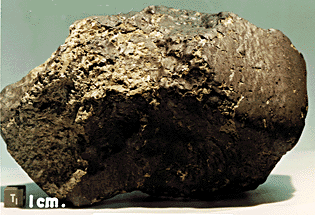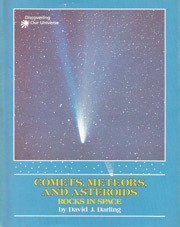COMETS, METEORS, AND ASTEROIDS: 5. Meteorites: Stones From the Sky

A meteorite from Mars known as ALH84001.
The biggest space rocks, comets and asteroids, hardly ever hit the Earth. The smallest meteors, burn up in the atmosphere. But medium-sized space rocks quite often crash into the Earth's surface. These are called meteorites.
About 500 meteorites strike the Earth every year. Since most fall in out-of-the-way places, or into the sea, they are difficult to find and study. But a few are found. These are looked at carefully to discover what they are made of and where, in space, they may have come from. To scientists, they are very important. Apart from rocks brought back from the Moon, they are the only samples we have of matter from beyond our planet.
Meteorites can range in size from small pebbles to huge boulders. The largest ever found weighs 60 tons, measures 10 feet across, and landed thousands of years ago in Namibia in southwest Africa. It has never been moved from where it fell. Another, discovered in Greenland, weighs about 34 tons. It is now on display in the American Museum of Natural History in New York.
Even larger meteorites have hit the Earth in the past. They have left behind huge IMPACT CRATERS – hollows in the ground surrounded by steep, rounded walls.
The most famous crater, thought to be about 50,000 years old, is near Winslow, Arizona. Called the Barringer crater, it measures 4,000 feet across and was probably caused by a giant meteorite weighing around one million tons.
Older, more weathered craters, known as ASTROBLEMES, have been found in remote parts of Canada, the Soviet Union, and South Africa. The most striking one of all is the Vredefort Ring in the Transvaal of South Africa. Measuring 30 miles across, it is the giant scar left by a mile-wide object that smashed into the Earth about 250 million years ago.
Such big impacts are rare. But there have been one or two recent near misses. In 1908, a large space rock exploded over the Tunguska river valley in Siberia. Scientists now think that it was probably not a meteorite. Instead, they believe, this object was a small comet that burned up as it raced through the atmosphere.
In 1972, a 1,000-ton meteoroid streaked across the skies of the western United States. It flew safely by at a distance of just 36 miles (58 kilometers) above the Earth before disappearing back into space.
Even when meteorites do hit the Earth they usually land far away from people. A few, though, have paid unexpected visits. On April 25, 1969, a one-pound space rock ended its journey by dropping through the roof of the Sprucefield police storehouse in Northern Ireland!
Meteorites are the best understood of all space rocks. They come in three main types: stony meteorites, stony-iron meteorites, and iron meteorites. Of these, the stony variety is the most common. Only about one in twenty meteorites is an iron, which is made of an iron-nickel mixture. Rarest of all are the stony-irons.
Some of stony meteorites, known as chondrites, are among the oldest objects ever found. Their age may be more than 4½ billion years – greater than that of the planets. To scientists, chondrites are exciting because they have been found to contain organic matter. This discovery proves that at least some of the substances on which life is based have also been formed in space.
No one is really sure where all of the 2,000 known meteorites have come from. It seems likely that many of them are pieces of asteroids that have broken off and found their way to earth. But the link between meteorites and asteroids isn't as strong as that between meteor showers and comets.
Perhaps new clues to help solve this mystery will come from Antarctica. For here, in the ice of the great southern continent, scientists have uncovered a vast number of frozen meteorites. The cold, dry climate has kept them exactly the way they were when they fell.
Among the Antarctic meteorites are several that have come, not from an asteroid, but from the planet Mars! Altogether about 30 Martian meteorites have been found on Earth. Scientists have compared the makeup of gas trapped in these unusual space rocks with that of the Martian atmosphere as measured by the Viking spacecraft, which landed on the planet in 1976, and found a near perfect match. It seems that these rocks were hurled into space by asteroids that crashed into Mars long ago, eventually finding their way to our own world. Other meteorites have been found on Earth that came from the Moon.
There are still many unanswered questions about the rocks that speed through space and sometimes come close to or collide with our world. The mysteries of comets, asteroids, and meteors will be solved only when more spacecraft are sent to explore them.
In years to come, spacecraft will chase comets around the Sun, fly through the heart of meteor storms, and land on the surface of distant asteroids. All these missions will add to our understanding of the mysterious rocks in space.

